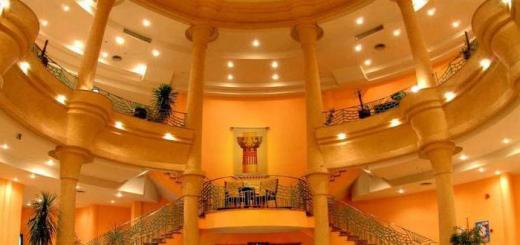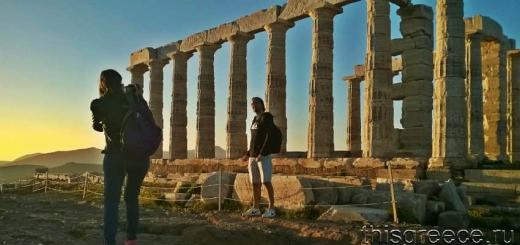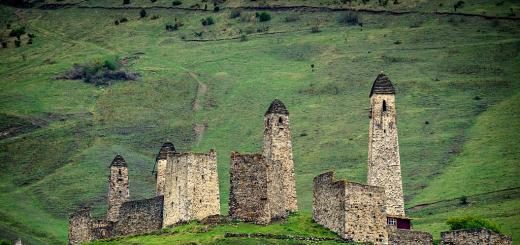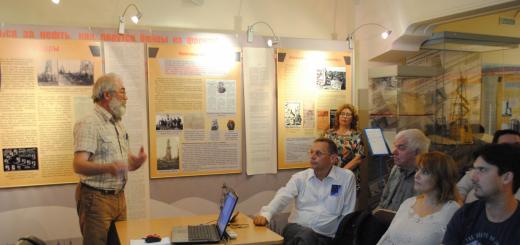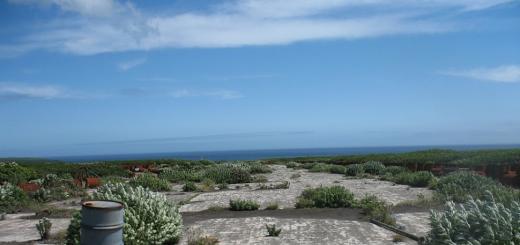Seven wonders of the world- these words have become a part of everyday life. They are used when they want to emphasize the outstanding merits of either a work of art, or a grandiose structure, or a scientific discovery. But why are there seven miracles? Is this number randomly chosen? The number "seven" has been revered since ancient times. Since then, as the calendar was based on the lunar month. There are 28 days during the lunar month. During this period, the moon arrives and wanes, passing through 4 phases (quarter moon, half, full moon, new moon). These phases of the moon change every seven days. Seven celestial bodies, including the Sun and the Moon, were associated with certain celestial deities of the ancient Babylonians. A seven-tiered tower was built in their honor in Babylon. The same Babylonians believed that a deceased person passes through 7 gates in the kingdom of the dead. The ancient Greeks also attached great importance to the number 7. In the legends of the Minotaur, the Athenians were obliged to sacrifice 7 youths and 7 girls. Seven is the sacred number of Apollo. The sages whom the Greeks revered were also 7. The ancient Greeks associated the idea of something complete and perfect with the number 7. More often than others, the ancient authors attributed to the number of seven wonders of the world:
Everyone knows how many interesting, sometimes amazing scientific discoveries were made by scientists on the ancient Egyptian land. Her tombs and temples gave a lot of miraculous finds. But the greatest miracle of Egypt, which amazed people even in antiquity, was the pyramids - these amazing artificial mountains - the tombs of the ancient Egyptian kings. Travelers sailing on the yellow waters of the Nile were always struck by a sharp edge where the Nile Valley with its green fields and date groves is replaced by the hot sands of the dead Libyan desert.
Farther west are visible amazing mountains... They are of the correct shape and stretch for tens of kilometers - from modern city Cairo to Fayum oasis.
It - Egyptian pyramids ... They seem to grow out of the desert sands - colossal, majestic, overwhelming a person with their extraordinary size and severity of outlines. Standing at the foot of the pyramid, it is difficult to imagine that these huge stone mountains were created by human hands. And yet they were really built from separate boulders, as children of our time put together pyramids from cubes. Thousands of hands of slaves and Egyptians subject to Pharaoh were busy with hard and useless work - creating a huge stone mountain, which was supposed to hide in its bowels the dead body of the Egyptian king. By creating an eternal tomb, Pharaoh provided an eternal dwelling place for his immortal spirit.
Pharaoh Djoser was the first of the Egyptian kings to erect a pyramid over his tomb. This very ancient pyramid Egypt has six huge steps. Before the construction of the first pyramid in Egypt, tombs were erected with a massive rectangular above-ground part made of stone. In form, they resemble Arab benches - mastabas - and under this name they entered science. Djoser's pyramid was essentially six such mastabas, stacked one on top of the other, decreasing upward. The creation of the world's first stone structure of such a significant size (height about 60 m) is attributed to Imhotep - a remarkable medical scientist, mathematician and architect, the former vizier of Tsar Djoser. The fame of Imhotep was so great that after several centuries his name was surrounded by legends. From a later time, figurines have been preserved depicting this remarkable architect. Apparently, Pharaoh Djoser himself was so pleased with the unprecedented tomb built by Imhotep that he allowed to carve the name of the architect on the base of his statue - an honor completely unheard of in ancient Egypt. During the excavation of the funeral temple, located near the pyramid of Djoser, scientists found fragments of several statues of the pharaoh and among them a pedestal on which the name of Imhotep was written.
Excavations near the pyramid of Djoser revealed a whole "city of the dead" surrounding the tomb of the pharaoh. Mastabas were built around - the tombs of members of the royal family and nobles close to the pharaoh. There was also a memorial temple where sacrifices were performed in honor of the deceased pharaoh. During the excavation of the temple, archaeologists discovered a hall decorated with the world's oldest columns. True, these were not yet ordinary round columns, they only half protruded from the walls, but Imhotep long before the Greek architects created the prototype of the strict and slender Dorian colonnade.
The funeral temple and the pyramid were surrounded by a wall of white limestone and, according to the architect's plan, constituted a single architectural ensemble.
The largest pyramid was built by Pharaoh Khufu (or Cheops in Greek), who lived in the XXVIII century. BC.
This huge pyramid has been standing for almost five thousand years. Its height reached 147 m (now, due to the collapse of the summit, its height is 137 m), and each side is 233 m long. To go around the Khufu pyramid in a circle, you need to walk about a kilometer. Until the end of the 19th century. the pyramid of Khufu was the tallest structure on earth. Its immense size amazed everyone who was in Egypt. No wonder the first Russian travelers who came to Egypt called the pyramids "man-made mountains".
Scientists have calculated that the Khufu pyramid was composed of 2,300,000 huge blocks of limestone, smoothly polished, and each of these blocks weighed more than two tons. The carefully hewn and polished limestone blocks were so skillfully fitted one to the other that it was impossible to insert a knife blade into the gap between the two stones.
The stones were tightly adjacent to one another and held on by their own weight. The accuracy of the work of masons and grinders is surprising, especially if you imagine that the ancient artisans, who created such grandiose monuments of human labor, still used stone tools. In the quarries on the right bank of the Nile, near the ancient capital of Egypt, Memphis, thousands of workers mined stone for the construction of the pyramid. Along the boundaries of the stone block marked on the limestone rock, the workers gouged deep grooves in the stone. This work took a lot of effort and labor. Having hollowed out depressions in the furrow, the workers hammered wedges of dry wood into them and poured water over them. The wet tree began to swell, the crack widened, and a lump broke off from the rock. The chipped stone was pulled out of the quarries using thick ropes woven from papyrus (such ropes were found in ancient quarries). Limestone boulders were then hewn out by stonecutters here and there together. Stonecutters worked with a variety of tools made of wood, stone and copper. This work, of course, was easier than the work of mining the stone, but even here it was necessary from dawn to dawn to work under scorching sun... Blocks of white facing limestone on boats were transported to the other side of the Nile. They were brought to the construction site by loading them onto special wooden skids.
Ancient Greek historian Herodotus, who visited Egypt in the 5th century. BC, was the first scientist who reported in detail the information he collected about the pyramids. The work of Herodotus was an extensive narrative, consisting of nine books, in one of which he described his journey to Egypt.
According to the story of Herodotus, in order to drag the stone blocks up, an inclined embankment was built. Subsequently, it was leveled. On it, the builders, driven by the sticks of the overseers, pulled heavy stones on the ropes, which, with the help of a wooden lever, were set in place. How many people died under the weight of a broken stone block, how many were crippled while laying stones, how many died from backbreaking labor here, near the walls of the pyramid that were still unfinished! And this for twenty long years. When the laying of the pyramid was completed, its steps were laid with facing blocks. They were brought from quarries located in Upper Egypt, near Aswan. On the ledges of the pyramid, the facing blocks were lifted up and laid from top to bottom. Then they were polished. Under the rays of the southern sun, they shone with dazzling brilliance against the background of the cloudless Egyptian sky. Herodotus says that the construction of the Khufu pyramid lasted about twenty years. Every three months, workers changed, the number of which reached 100,000. The scourge of overseers, exhausting heat, inhuman labor did their job. After all, there were no machines for lifting two-ton limestone boulders. Everything was done only with the help of human strength. Even if you accept it. Considering that Herodotus made a number of obvious exaggerations and inaccuracies, the figures he cited still give an idea of the grandiose scope of the work undertaken by Cheops to create a colossal tomb.
The entire burial structure was almost continuous masonry. The entrance to the pyramid was always located on its northern edge, at a height of about 14 m from the ground. There were several chambers inside the pyramid, of which only two were burial chambers. One, the lower one, as scientists assume, was intended for the king's wife. The second, somewhat larger (10.6 x 5.7 m), located at a height of 42.5 m from the base of the pyramid, served as the tomb of the pharaoh himself. It contained a sarcophagus of red polished granite. Above the tsar's burial chamber, one above the other, there are five blind chambers, apparently intended to distribute pressure above the chamber. In the thickness of the pyramid there are several narrow and long passages leading to the chambers inside the pyramid and to the chamber dug under its base. Scientists also traced two ventilation slots that penetrated the thickness of the masonry and went from the chamber of Cheops himself. When clearing the surface of the pyramid, many blocks were marked with red paint marks containing the name of Pharaoh Khufu. Parts of the ancient facing were discovered by archaeologists while clearing the bottom of the pyramid, covered with sand. The tiling of the facing stones was so perfect that it was impossible to immediately determine the places of their connection. And when photographing this cladding, the researchers had to specially paint over the seams where the blocks closed. We can safely say that none of the kings who ruled after Khufu could surpass his tomb in size and grandeur, but the name of the pharaoh, who decided to glorify himself with the construction of a pyramid of unprecedented magnificence, was hated by the Egyptian population for many centuries.
The second largest pyramid after the tomb of Khufu is the pyramid of Pharaoh Khafre (Khafre). It is 8 m lower, but less destroyed. The top of the pyramid has retained some of the polished cladding. The rest of the pyramids are much smaller, and many of them are badly destroyed.
Near the pyramid of Khafre, a hill rises from the sand of the desert. Its height is about 20 m, length is about 60 m. Approaching the hill, travelers see a huge statue, carved almost entirely from the rock. This is the famous big sphinx - the figure of a reclining lion with a human head. His face was cracked, and his nose and chin were chipped off. So Muslim Arabs crippled a statue that stood for millennia. The Arabs believed that evil spirits lived in the statues of the ancient Egyptian gods, and therefore tried to destroy as many of their images as possible. With such a giant as the big sphinx, they could not cope, but they disfigured him thoroughly.
"Father of Horror" - that's what they call great sphinx the inhabitants of the desert. He instills the greatest fear in them at night, illuminated by a bright moon, when deep shadows give his features a special expressiveness.
In ancient Egypt, not every mortal had the right to approach the pyramid - this "eternal horizon", beyond which the Pharaoh "went" (they did not say about Pharaoh that he died - he "went" beyond the horizon, like the sun; Egyptian kings called themselves sons sun). In order for those who wish to be able to honor the memory of the deceased pharaoh without offending his greatness, a memorial temple was erected at some distance from the pyramid - something like a reception hall of the deceased king. Massive rectangular pillars of polished granite supported the ceiling. The granite walls and floor of the building have been carefully polished.
In order to preserve the king's body from decay, which was the abode of his soul (the Egyptians called it Ka), he was embalmed.
Pharaoh's relatives and priests took care that the deceased was not in danger in underworld so that he could move freely within his tomb and that the gods accept him as an equal. Therefore, often the walls of the rooms inside the pyramids are dotted with prayers and spells. The doors that led from one room to another or from the corridor to the cell were subjected to a particularly careful spell. On the walls adjacent to the doors, there are images of door guards - baboons, wolves, lions, and spells against them and evil demons who threaten the deceased pharaoh. These texts found in a large number, are one of the most ancient works of religious literature. Scientists named them after the place where they were found "Pyramid Texts".
Taking care of the safety of the spirit of the deceased in the afterlife, his relatives did not forget about vital things. Jewelry and various items belonging to the pharaoh were kept in special rooms. After all, the ancient Egyptians believed that the deceased continues to live after death, that he needs all those things that were necessary for him during his life. And the magnificent tomb of the king served as his home, as during his lifetime the house was a magnificent palace.
On holidays in memory of the deceased pharaoh, a solemn procession headed to his pyramid. In the hall with columns in front of the image of the pharaoh, "seated next to Ra", prayers were performed and sacrifices were offered. These days in " city of the dead" near large pyramids it was noisy and lively.
To the pyramid - the consecrated resting place of the pharaoh, who became a deity - a mere mortal did not dare to approach. However, the riches that filled the storerooms of the royal tomb were a great temptation for robbers. The pyramid builders foresaw this too. The entrance to the crypt was closed from the inside with a heavy keystone. After the end of the funeral ceremonies, supports were knocked out from under the stone and the entrance to the central chamber of the pyramid, where a magnificent granite sarcophagus with the body of the pharaoh stood, was closed forever.
The same huge stone, lowered down the inclined passage into the crypt, closed the passage to the corridor.
The well, through which people descended, after all entrances and exits were walled up, was filled up. The royal tomb was inaccessible to humans and demons. Pharaoh could rest peacefully under a hundred-meter-high pyramid hanging over the vaulted crypt.
But all the precautions were in vain. The tombs of the kings were plundered in antiquity, and only empty halls and complex passages inside the pyramids have survived to this day.
But although the texts of the pyramids praised the divine power of the pharaoh, although the powerful walls of the pyramid reliably sheltered the king's burial, the huge granite sarcophagi in the pyramids of kings Khufu and Khafre are empty. Even in antiquity, temples were destroyed at the Khafre pyramid. Huge statues of Pharaoh Khafre were smashed and thrown into a well, from where they were recovered by archaeologists during excavations. It was clear that these magnificent statues of dark hard stone had not suffered from time to time. They were deliberately damaged, smashed to pieces, crippled.
In Egypt, even the most distinguished person did not dare to think about building such a burial structure as a pyramid. Only Pharaoh, son of the Sun, could have such a grandiose tomb. The tombs of the noble Egyptians were either hewn out of the rock, or built of stone or brick. These were low rectangular structures built over the crypt. The tombs of the Egyptian nobility are usually crowded around the pyramids, as if the nobles and after death wanted to be closer to the pharaoh.
These mastab tombs usually had several rooms. In the main one there was a sarcophagus with the body of the deceased. In one of the rooms, belongings belonging to the owner of the tomb were stacked. In a small room there was usually a statue of the deceased. The walls of the mastabas were decorated with paintings or painted reliefs. The colors of the paintings are striking in their brightness and freshness. The liveliness and subtlety of the drawing were amazing. But Egyptian artists worked with rather coarse brushes made from pieces of fibrous wood. At one end, such a piece was broken with a stone until it crumbled, forming a rough fringe. With such primitive brushes (several brushes with the remnants of paint on them were found in tombs), artists created graceful, picturesque images that adorned the walls of the tombs.
Here you can see scenes of everyday life - harvesting, sowing, artisans and farmers at work, hunting, boating on the Nile, dancing girls, dancing warriors. Common people, hardworking and talented, such were the Egyptian laborers depicted in their usual pursuits.
And not the nobles - the owners of the rich, decorated with paintings mastabs, who boastfully listed their services to the Pharaoh, immortalized themselves by the construction of these tombs, but modest workers, whose names are not named in the inscriptions.
They built irrigation canals and dams, they carved magnificent statues, erected beautiful temples, decorated the walls of buildings with wonderful reliefs full of life's truth. And in these pictures of everyday life, they immortalized themselves, their inconspicuous work, without which the entire thousand-year-old culture of Egypt could not exist. Without knowing it, they have preserved to this day on the stone pages of the walls stories about their hard working life, about the forced existence of some and the prosperity of others, about their sorrows, amusements and amusements.
Latest ratings: 5 5 5 1 5 5 5 5 5 1
The Egyptian pyramids are the most famous structures on Earth. And the most ancient ones, after all, they are already five thousand years old! It is probably impossible to find a person who has not heard of them. Unless somewhere in the jungles of Polynesia you can find people so far removed from civilization. However, very few can tell about them.
These gigantic tombs of the fourth dynasty of the pharaohs stand on the outskirts of Cairo, as if specifically so that tourists can conveniently travel to them by taxi. But this is certainly not the case. For five thousand years, the capital of Egypt has moved from city to city many, many times, while the pyramids have always remained in one place - in the lower reaches of the Nile, where the roads that go to Asia and Europe intersect. So it would be more correct to say that the capital has returned to them.
For a very, very long time, the Egyptian pyramids were the tallest buildings on Earth. Only at the end of the nineteenth century, when the Eiffel Tower was built in Paris, it overtook the Cheops pyramid in height. And all the same it remained a formal game of numbers - they are too different from each other.
And if you try to imagine the weight of the pyramid - and it weighs more than six million tons, then this is quite commensurate with the weight of all buildings in Moscow within Garden Ring... It turns out that the whole city is hidden in one pyramid.
But what is most striking is that all this is built by hand, without mechanisms. Only wooden wedges and sledgehammers helped people cut out huge blocks of limestone, and dragged them into place with the help of papyrus ropes. It took twenty years to build the pyramid, and every three months one hundred thousand workers came to the construction site. How many of them survived until the end of this period, history is silent. Most likely, there weren't that many of them.
Why did people build such grandiose structures that required such tremendous efforts and sacrifices? It is very difficult for a modern person to understand this, although this riddle is not so difficult.
In ancient times, kings were considered direct descendants of the gods, which means that their word was the law for everyone. Therefore, the ruler, as in a well-known fairy tale, could well order his subject: "Go there, I don't know where, bring that, I don't know what."

He had enough money, because both the conquered peoples and his own people carried tribute to him. Perhaps it is even more correct to say that he had a lot of extra money, because he could no longer eat up or drink the excess, and the idea of giving it to those in need simply did not occur to him. There were no such cases in history.
And in order to show everyone his greatness, the ruler ordered the architect: “Build something that has not been found anywhere else in the world, so grandiose that the gods rejoice. And let this building reach the sky! " Such a task was difficult, but it did not seem impossible. Indeed, in ancient times, people were sure that the sky was solid and was not at all high.
Moreover, the gods sit on it, like on a platform, and look at them from above, so if you go up closer to them, they will surely see and hear a person.
The great architect of the ancient world Imhotep was exactly the one who was able to figure out how to fulfill such a task of the pharaoh. He proposed to build a multi-storey pyramid of stone, where each next floor will be smaller than the previous one.
Before that, stone was not used in Egypt for construction, houses were built of wood and reed, coated with clay, and adobe bricks were used for palaces and tombs. And all the buildings were rectangular in shape, like a matchbox. Imhotep proposed to put such "matchboxes" on top of each other, gradually reducing them to the top.

But here's what's interesting: this form was not at all unique to the ancient world. Around the same time, huge ziggurats were being built in the neighboring state - in Mesopotamia. This was the name of the multi-storey clay brick pyramids, on the top of which the temple was erected. Probably, they hoped that this way God would better hear the requests addressed to him.
And it is even more remarkable that very similar stone pyramids with temples on top were also built on the other side of the Earth, in America. And if Egypt and Mesopotamia can still argue about who first invented the pyramid, then the Americans almost certainly invented it themselves.
Well, in Egypt, where the living God ruled the people, there was no need to erect a temple on the top. The pyramids themselves, with all their appearance, inspired awe of the pharaoh, especially since in the time of Herodotus they were dazzlingly white and absolutely smooth.
Only much later, at the beginning of the fourteenth century, a strong earthquake occurred in those places, and the white cladding crumbled. On the walls of the pyramids, ledges appeared, along which tourists today quite successfully climb, who do not at all feel lofty feelings for the long-disappeared pharaohs.
Moreover, it is the only one that has survived to this day. A lot of facts have been written about this unique building, and you can read all of them on Wikipedia. We want to designate general concepts pyramids, and Interesting Facts about her.
First of all, you should know that it is the largest pyramid in Egypt. Previously, its height was about 146 meters, and today it is about 138 m. The date of the beginning of construction dates back to around 2600 BC, although this is inaccurate and is disputed by many scientists.
Pyramid of Cheops - the first wonder of the world
Today, this stunning building surprises with its size and incredible accuracy of engineering calculations. It seems that the ancient Egyptians perfectly knew the principle of the golden ratio, possessed the secret of the number Pi and other scientific knowledge that were discovered much later.
There is speculation that these stone giants are space observatories. After all, the shape of the location of the pyramids exactly repeats the contours of "Orion".
Others believe that these buildings used to play the role of powerful energy generators. They were originally covered in limestone, and shone like supernatural beacons.
 Fragments of cladding, with which the pyramid was initially completely covered
Fragments of cladding, with which the pyramid was initially completely covered Inside the first wonder of the world - the pyramids of Cheops, you will find three chambers: underground, "Queen's Chamber" and "Pharaoh's Chamber". You can get inside the artificial mountain through a natural entrance located at a height of about 15 meters (somewhere like a 5-storey building) or through an artificial one, which was pierced in 820.
If you have ever been to the Giza plateau and saw the described facts with your own eyes, then you are unlikely to soon forget unique miracle light - the pyramid of Cheops.
 The pyramid of Cheops in section
The pyramid of Cheops in section On our website you can find another interesting article about how the largest Egyptian pyramid was opened. I must say that many secrets become clear only upon closer examination.
Egyptian pyramids
One of the most mysterious and carefully researched wonders of the world that has survived to this day is the Egyptian pyramids.
Huge man-made mountains, created according to the calculations of famous and respected architects in Egypt, using amazing Of the ancient world technologies, became the tombs of the rulers of Ancient Egypt - the pharaohs. The oldest is the step pyramid of Pharaoh Djoser, who ruled Egypt about 5000 years ago. Before him, the rulers of Egypt were limited to tombstones of a simpler design. Djoser turned to the architect Imhotep with the wish that his tomb surpassed all those still erected, providing him with a peaceful and tranquil afterlife existence. So the first pyramid was built, reaching a height of 60 m.
The pyramid, in which all the geometrical parameters are carefully calculated, the edges of which are oriented to the cardinal points and polished, creates a favorable environment in a certain place of its inner space, contributing to the preservation of the body of a deceased person.
The most famous all over the world are the pyramids at Giza, intended for the pharaohs Cheops, Khafre and Mikerin. The Pyramid of Cheops is huge, it simply overwhelms with its size - 147 m in height, the length of each side is 233 m, the occupied area is almost 50,000 sq. M. In this case, the sides of the pyramid are oriented to the cardinal points with an accuracy of 4 arc minutes. The pyramids are made of solid masonry. The stone blocks from which they are built weigh from 2.5 to 15 tons. How did the ancient craftsmen manage to build such a miracle?
There are many hypotheses about how the pyramids were built. The American engineer John Bush, for example, put forward a hypothesis according to which huge blocks were rolled over long distances using large round blocks. He conducted successful tests of such devices. Lumps of limestone used in the construction of the pyramids were mined on the opposite bank of the Nile and transported by boat.
There are more unusual assumptions about the construction of the pyramids. According to them, the pyramids are the work of the cosmic progenitors of mankind or the inhabitants of the sunken Atlantis, who hid information about secret knowledge under the pyramids.
The ancient Egyptians believed that the deceased, buried according to all the rules, awaits resurrection in a special afterlife. The tomb becomes his home, in which his mummy (carefully embalmed imperishable body) is preserved, as well as many twin sculptures and images of objects, animals and people that may be useful to him in the afterlife.
From the book Empire - I [with pictures] the author1. 2. Egyptian pyramids have not yet been built There are no Cyclopean buildings familiar to us today - pyramids, sphinxes, temples, obelisks - in this kingdom yet. All of them will be erected significantly
From the book Empire - II [with pictures] the author Nosovsky Gleb Vladimirovich10. Egyptian pyramids are Scythian burial mounds. It is generally believed that the Egyptian pyramids are something unique and unrepeatable. At least neither in Europe nor in Asia there are supposedly pyramids and never have been. In fact, this is not the case. The pyramids are well known in Eurasia and, in
From the book The newest book of facts. Volume 3 [Physics, chemistry and technology. History and archeology. Miscellaneous] the author Kondrashov Anatoly Pavlovich From the book Who's Who in World History the author Sitnikov Vitaly Pavlovich From the book of 7 and 37 wonders author Mozheiko IgorThe first miracle. Egyptian pyramids The Egyptian pyramids are the most famous structures on Earth. You will not find more famous. Moreover, they are the most ancient of the famous. Giant tombs of the pharaohs of the fourth Egyptian dynasty - Khufu (Cheops) and Khafra (Khafren) -
From the book Reconstruction of World History [text only] the author Nosovsky Gleb Vladimirovich10. THE EGYPTIAN PYRAMIDS ARE THE Scythian Mounds It is generally believed that the Egyptian pyramids are something unique and inimitable. At least neither in Europe nor in Asia there are supposedly pyramids and never have been. In fact, this is not the case. The pyramids are well known in Eurasia and, in
From the book The Beginning of Horde Rus. After Christ, the Trojan War. Founding of Rome. the author Nosovsky Gleb Vladimirovich12.3.5. Egyptian pyramids and pyramidal cottage cheese Easter It is possible that the chronicle story about Olga's third revenge also reflects the construction of the three Great Pyramids in the Giza valley, in Egypt. Which, as we said in the book "Empire" and in CHRON5, ch. 19: 4 probably
From the book The First Wonder of the World. How and why the Egyptian pyramids were built the author Nosovsky Gleb Vladimirovich3. Egyptian pyramids and Scythian burial mounds They may object to us: if the pyramids in Egypt were really built by the Great Russian Medieval Empire, then it means that in Russia there should have been something similar to the pyramids. Does the Egyptian pyramids have a RUSSIAN sample? Yes,
From the book New Chronology of Egypt - II [with illustrations] the author Nosovsky Gleb Vladimirovich10.1. Egyptian pyramids and Scythian burial mounds Many people think that the Egyptian pyramids have no analogues in Europe. In fact, this is not the case. The analogs of the pyramids are well known in Eurasia and, in particular, in Russia. These are mounds. If we compare the pyramid with a mound, then it is easy to understand that
From the book of the Pre-Columbian voyages to America the author Gulyaev Valery IvanovichChapter II Egyptian pyramids and Mexican teocallis At the end of the 19th - beginning of the 20th centuries, after a number of major archaeological discoveries, one of the brightest pages appeared in front of the world in all its splendor ancient history humanity - Egyptian civilization.
From the book Book 2. The flourishing of the kingdom [Empire. Where Marco Polo actually traveled. Who are the Italian Etruscans. Ancient Egypt. Scandinavia. Rus-Horde n the author Nosovsky Gleb Vladimirovich10. Egyptian pyramids are Scythian burial mounds It is generally believed that the Egyptian pyramids are something unique and inimitable. At least, neither in Europe nor in Asia there are supposedly pyramids and never have been. In fact, this is not the case. The pyramids are well known in Eurasia and, in
From the book Secrets of the Ancient Pyramids the author Fisanovich Tatiana MikhailovnaPART I THE EGYPTIAN PYRAMIDS
From the book World History in Persons the author Fortunatov Vladimir Valentinovich1.6.1. Who Built the Egyptian Pyramids? Some authors claim that the Egyptian pyramids were built ... by the Russians. Their civilization existed long before the Egyptian. And these Russians flew in not from anywhere, but from the North Star.
From the book The Curse of the Pharaohs. Secrets of Ancient Egypt the author Reutov SergeyEgyptian pyramids Almost every person at the mention of Ancient egypt associations arise primarily with pyramids. What were they like? Let's take a look at the architectural features first. In the pre-dynastic period in Egypt were widespread
From the book Technique: From Antiquity to the Present the author Khannikov Alexander AlexandrovichEgyptian pyramids at Giza Between 2800 and 1600 BC NS. pyramids were built in Egypt. Real stone masses were built during the times of Cheops, Khafren and Mikerin. They rise among the sands of the Libyan Desert and stretch for tens of kilometers from Cairo to Fayum
From the book Wonders of the World the author Pakalina Elena NikolaevnaEgyptian pyramids One of the most mysterious and thoroughly researched wonders of the world that has survived to this day is the Egyptian pyramids.
"Herodotus called" the first wonder of the world ", still excite our imagination, although it would seem that today it is difficult to surprise us even with the most modern achievements of science and technology. However, the pyramids keep their secrets for more than one thousand years.
The first pyramid in Ancient Egypt was built around 2700 BC. NS. It was built by order of the founder of the III dynasty of the rulers of Egypt, Pharaoh Djoser. Since then, many pyramids and other large stone structures have been built.
The most famous pyramids
Most of all, the attention of people is attracted to the pyramids of two pharaohs of the IV dynasty - Cheops and his son Khafre. The Pyramid of Cheops has a square of 232.4 x 232.4 meters at the base and a height of 146.7 meters. The pyramid of Khafre, respectively, is 215.3 x 215.3 meters and 143.7 meters. Until now, they remain the largest structures that have ever been created by man.
It is not surprising that during their almost 5000-year existence, many myths, legends and hypotheses related to their origin have arisen. The first information about the construction of these pyramids came to us precisely from Herodotus.
In the 5th century BC. NS. he visited Egypt, visited the pyramids, described the technology of their construction from the words of the Egyptian priests. He said that the pyramids were built by 100,000 people over 20 years. In 1883, the English Egyptologist Petrie confirmed by his calculations the veracity of Herodotus' information.
Astronomical riddle of the pyramids
And yet another unexplained mystery is the high knowledge of the Egyptians in the field of astronomy. The Pyramid of Cheops, for example, almost unmistakably points to true north. As a result of the most accurate measurements made in 1925, such an incredible fact was established: the error in the position of the pyramid is only 3 minutes 6 seconds.
For comparison: in 1577, the Danish astronomer Tycho Brahe, through long and careful calculations, oriented the Oranienburg Observatory so that it faces north. In the end, he was still 18 minutes wrong.
In addition, the error of the Egyptians is explained by the slight displacement of the north itself over the past millennia. Striving for precision is a sign of the high development of civilization. This astonishing precision is everywhere, including in the dimensions of the pyramid base.
With an average size of the sides of about 230 meters, the difference between the largest and smallest sides does not exceed 20 cm, that is, about 0.1%. In addition, the ancient builders erected the Cheops pyramid with almost perfect right angles. It is also striking that it was not built on a flat area, but on a natural hill 9 meters high, which turned out to be in the very middle of the base of the pyramid.
British physicist K. Mendelssohn poses the question: how, without modern scientific instruments, the ancient Egyptians could determine the direction to the desired point in the air and build directly in the direction to it? A mistake of even two degrees could lead to disastrous results in the end. He proves that a central pivot could have been used in the first stage of construction. In this way, the marker at the top helped align the edges.
However, the mysteries of the external characteristics of the pyramids are still flowers. What is happening inside is also amazing. It is still not known exactly why the effect of mummification of any organic matter appears inside the pyramid oriented to the cardinal points. The bodies of small animals that died in the pyramid, even without embalming, are mummified and preserved for a very long time.
Amazing properties of the pyramids
In addition, in the pyramid, blunt razor blades, placed with the same orientation to the cardinal points, are sharpened in a short time. It is important to note that the mummification effect is most pronounced in the center of the pyramid, at about 1/3 of its height. The burials of the pharaohs were located at about this height.
There were also several rooms in which there was the pharaoh's mummy, various cult objects, sacred manuscripts, very often a spare sarcophagus stood next to the sarcophagus with the pharaoh's mummy. In the literature, you can often find a mention of the "curse of the pharaoh". A person who entered the tomb of the pharaoh is subjected to the curse of the pharaoh and soon dies.
Most likely, the Egyptian priests, before closing the tomb, left some kind of substance that contained disease-causing lung bacteria. In the pyramid, under the influence of the effect of mummification, they seemed to fall asleep, but did not die.
However, when a person entered the pyramid, most often for the purpose of robbery, he carried these bacteria outside, where they woke up and infected the robber with an incurable disease. It is noticed that most of the so-called "damned" died from diseases associated with the respiratory system. True, this version has not yet been proven.
All these mysteries associated with the first wonder of the world gave rise to mystical and fantastic hypotheses. So some researchers even question the human copyright for these colossal buildings. In the last century, for example, the London bookseller John Taylor argued that the level of mathematical, astronomical and technological knowledge in ancient Egypt was low.
Who helped the Egyptians build the pyramids?
Therefore, Taylor concluded, people could not build the pyramid themselves, "God inevitably had to help them." In our time, the author of the famous book "Recollection of the Future" Erich von Deniken believed that the pyramid of Cheops testifies to the existence of "unknown technology" used by space aliens.
By the way, not so long ago similar hypotheses of S. Proskuryakov and V. Romanov were published in newspapers. And an article in one of the Moscow newspapers said: “As you know, during the first space launch of an American spacecraft towards Mars, cameras recorded traces of an ancient civilization on the planet's surface.
Scientist Richard Hoagland, together with a group of talented young mathematicians and physicists working in the field of astrophysics, as well as Pentagon cartographers came to the incredible conclusion: the giant pyramids and images of human faces photographed on Mars have the same origin as the Egyptian pyramids and the Sphinx. "
In fact, theories of the alien origin of the Egyptian pyramids arise from the fact that it is difficult for us to come to terms with the idea that ancient engineers and builders often surpassed us with ingenuity and ingenuity.
The pyramids, like other megaliths (dolmens, cromlechs, etc.), are actually ancient defensive structures.
http://forum.ozersk.ru/topic/32337-raskritie-tain-drevnosti
06.09.15
Rinat
All that is written is good, but how and who can explain the origin of a perfectly flat surface on basalt or granite - one of the hardest rocks of stone? I'm not talking about how blocks with a mass of 50 tons were lifted and the cuts in these very blocks with a diameter of half a centimeter, provided that modern technology is capable of making the same cut, but with a diameter of three millimeters? These questions themselves will answer for you - the technology of processing these soil rocks was used much higher than our technogenic level, which confirms the origin of cylindrical holes in fragments of one of the structures, and the same fact contradicts the theory that the ancient Egyptians were able to build it all with their own hands. There is no dispute, but if we compare, it is clear that the latter did not have any technological progress at all, but only a miserable resemblance those giants about whom they go for and against. In addition to everything, an interesting thing can be said about the fact that neither during the Greco-Roman events, nor in our time I have not found a single manuscript of the era of the reign of the pharaohs, which would talk about the construction of these great pyramids.
26.08.08
novel
I personally collected and tested a cardboard pyramid at home. All of the above is really true. Also revealed the effect of weight loss. A person loses weight by 10 kg per week in a dream without doing anything. I tested it on myself, my wife and my neighbor. I have lost weight from 75 kg to 60 and now I cannot gain weight so that I do not eat. The wife (without her knowledge) lost weight from 60 to 50 in a week and thought she was sick. Then I secretly planted a pyramid for a very well-fed neighbor, weighed at least 100 by eye for a month now, buying new things and altering old ones. Probably weighs no more than 70. I'm afraid it will become a mummy. We must secretly remove the pyramid. I do not apply for a patent, but it seems to me that women can be saved from a scam and "slim" for free, and the result is obvious (checked by scales), and not mythical. At the same time, eat what you want and live as you know. Please do not consider me a nutcase, as I am ready to answer with deeds for all my words. Consider this excursion as a free and real way to lose weight. The main thing is to observe dimensional accuracy when making pyramids.
18.06.05
, [email protected], Sonar
Everything is great. I learned a lot. Thank you, the material helped for the lesson and I myself am interested in Egypt as a whole and in parts.
03.05.05
, [email protected], Zhenya

